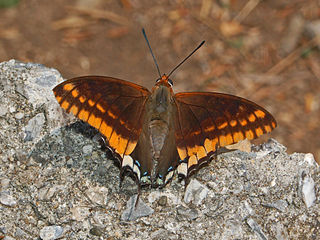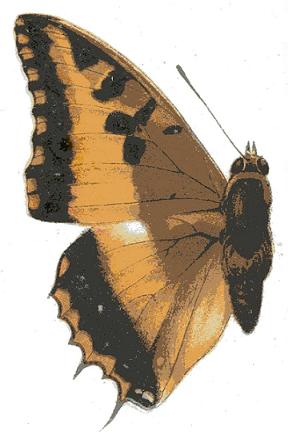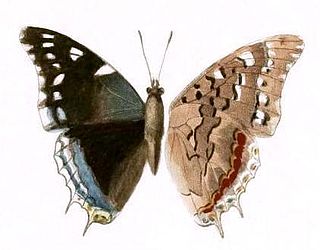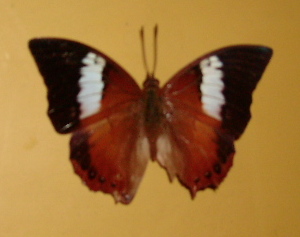
Charaxes jasius, the two-tailed pasha, is a butterfly in the family Nymphalidae. It is the only European species of the genus Charaxes. Divergence of the Mediterranean species C. jasius from the last common ancestor with its closest related species still flying in the Afrotropical realm most probably occurred around 2 mya, i.e. during the Pliocene.

Charaxes brutus, the white-barred emperor or white-barred Charaxes, is a butterfly of the family Nymphalidae. It is found in Africa.

Charaxes pelias, the protea emperor or protea charaxes, is a butterfly of the family Nymphalidae, and is endemic to the Cape Provinces in South Africa.

Charaxes druceanus, the silver-barred emperor or silver-barred charaxes, is a butterfly of the family Nymphalidae. It is found throughout tropical Africa.

Charaxes guderiana, the blue-spangled emperor, Guderian's charaxes or blue-spangled charaxes, is a butterfly of the family Nymphalidae. It is found in southern Africa.

Charaxes ansorgei is a butterfly in the family Nymphalidae. It is found in Sudan, the Democratic Republic of Congo, Uganda, Rwanda, Burundi, Kenya, Tanzania, Malawi and Zambia. The habitat consists of montane forest on altitudes between 2,000 and 3,000 meters. The larvae feed on Bersama abyssinica abyssinica, Bersama abyssinica englerana and Bersama paullinoides.It was once considered to be a very rare species but it is relatively common in dense and inaccessible montane forests

Charaxes pollux, the black-bordered charaxes, is a butterfly in the family Nymphalidae.

Charaxes etheocles, the demon charaxes, is a butterfly in the family Nymphalidae. It is found in Senegal, Guinea, Sierra Leone, Liberia, Ivory Coast, Ghana, Togo, Nigeria, Cameroon, Gabon, the Central African Republic, the Republic of the Congo, Angola, the Democratic Republic of the Congo, Sudan, Ethiopia, Uganda, Kenya, Tanzania and Zambia.

Charaxes doubledayi, Doubleday's untailed charaxes, is a butterfly in the family Nymphalidae. It is found in Sierra Leone, Ivory Coast, Ghana, Togo, Nigeria, Cameroon, Bioko, the Republic of the Congo, the Central African Republic, the Democratic Republic of the Congo and western Tanzania. The habitat consists of lowland tropical evergreen forests. It is a very rare butterfly

Charaxes latona, the orange emperor, is a butterfly of the rajahs and nawabs group, i.e. the Charaxinae group of the brush-footed butterflies family. It is native to the tropical rainforests of eastern Indonesia, western Melanesia and far northern Queensland, Australia, where it is limited to the Iron Range.

Charaxes mars, the iron rajah, is a butterfly of the rajahs and nawabs group, i.e. the Charaxinae group of the brush-footed butterflies family. It is endemic to Sulawesi in central Indonesia. Charaxes mars is a large butterfly with forewings with concave outer edge and hindwings each with a tail. The upper side of the forewings is dark blue and light in the basal part. The hindwings are orange with a submarginal line of dark brown ocelli.

Charaxes distanti is a butterfly in the family Nymphalidae. It was described by Eduard Honrath in 1885. It is found in the Indomalayan realm.

Charaxes borneensis,the White Banded Rajah, is a butterfly in the family Nymphalidae. It was described by Arthur Gardiner Butler in 1869. It is found in the Indomalayan realm.

Charaxes nitebis, the green rajah, is a butterfly in the family Nymphalidae. It was described by William Chapman Hewitson in 1859. It is found in the Indomalayan realm.

Charaxes affinis is a butterfly in the family Nymphalidae. It was described by Arthur Gardiner Butler in 1866. It is found in the Indomalayan realm.

Charaxes antonius is a butterfly in the family Nymphalidae. It was described by Georg Semper in 1878. It is endemic to Mindanao (Philippines) in the Indomalayan realm.

Charaxes bupalus is a butterfly in the family Nymphalidae. It was described by Otto Staudinger in 1889. It is endemic to Palawan in the Indomalayan realm.

Charaxes fervens is a butterfly in the family Nymphalidae. It was described by Arthur Gardiner Butler in 1896. It is endemic to Nias in the Indomalayan realm.

Charaxes ocellatus is a butterfly belonging to the family Nymphalidae. It was first described by Hans Fruhstorfer in 1896. This species is endemic to the Lesser Sunda Islands in the Australasian realm, near the Wallace line.

Charaxes epijasius, the cream-bordered charaxes or Sahel charaxes, is a butterfly in the family Nymphalidae. It flies through most of the Savannah of the Afrotropical realm except southern Africa.


















